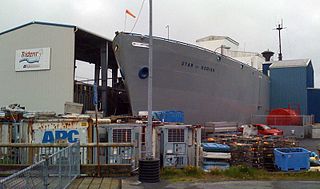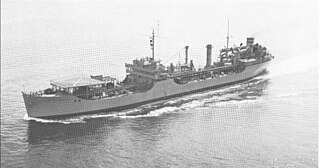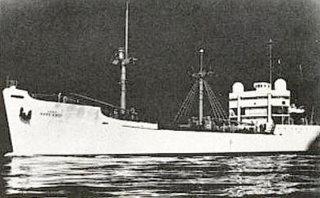
The War Shipping Administration (WSA) was a World War II emergency war agency of the US government, tasked to purchase and operate the civilian shipping tonnage the United States needed for fighting the war. Both shipbuilding under the Maritime Commission and ship allocation under the WSA to Army, Navy or civilian needs were closely coordinated though Vice Admiral Emory S. Land who continued as head of the Maritime Commission while also heading the WSA.

SS Albert M. Boe was a Liberty ship laid down on 11 July 1945 at the East Yard of New England Shipbuilding Corporation in Portland, Maine, as a boxed aircraft transport. The ship is notable as the final liberty ship built.

SS A. J. Cermak was a Liberty ship built in the United States during World War II. She was named after Anton Cermak, an American politician. Cermak was the Mayor of Chicago from 1931 until his assassination in 1933 while meeting with President Franklin D. Roosevelt.
SS Clara Barton was a standard Liberty ship, Type EC2-S-C1, built by the California Shipbuilding Corporation, Terminal Island, for the United States Maritime Commission and delivered to the War Shipping Administration (WSA) for operation as allocated by WSA during World War II. She was named after Clara Barton, the founder of the American Red Cross. The ship survived the war only to suffer the same fate as nearly all other Liberty ships that survived did; she was scrapped in 1970.

SS Mission Capistrano was a Type T2-SE-A2 tanker built for the United States Maritime Commission during World War II. After the war she was acquired by the United States Navy as USS Mission Capistrano (AO-112). Later the tanker transferred to the Military Sea Transportation Service as USNS Mission Capistrano (T-AO-112). She was a Mission Buenaventura-class oiler and was named for San Juan Capistrano in San Juan Capistrano, California.
SS Mission Loreto was a Type T2-SE-A2 tanker built for the United States Maritime Commission during World War II. After the war she was acquired by the United States Navy as USS Mission Loreto (AO-116). Later the tanker transferred to the Military Sea Transportation Service as USNS Mission Loreto (T-AO-116). She was a Mission Buenaventura-class oiler and was named for Misión de Nuestra Señora de Loreto Conchó, located in Loreto, Baja California Sur, Mexico, considered the "Head and Mother of all the California Missions."
USS Flambeau (IX-192), was the tanker S. B. Hunt, built for Standard Oil Company of New Jersey. Its keel was laid down in 1919 by Sun Shipbuilding and Drydock Company, in Chester, Pennsylvania with completion August 1919.
SS Daniel Webster was a Liberty ship built in the United States during World War II.

Booker T. Washington was a United States Maritime Commission (MC) Liberty ship and the first major oceangoing ship and first of 17 Liberty ships that were named after African-Americans. The ship was named for Booker T. Washington, notable educator, author, orator, and advisor to presidents of the United States. At launch Mary McLeod Bethune gave the address and notable singer Marian Anderson christened the ship.

SS Twin Falls Victory, named after Twin Falls, Idaho, was a Victory ship built for World War II. Converted to a Missile Range Instrumentation Ship, she was initially operated by the US Air Force as USAF Twin Falls Victory, before coming under US Navy control and being named USNS Twin Falls (T-AGM-11/T-AGS-37). She later had a third career as the training ship SS John W. Brown II.
USS Nausett (IX–190) was a tanker serving as an auxiliary ship in the United States Navy during World War II. Built as W. M. Irish the ship was a commercial tanker until taken by the War Shipping Administration (WSA) during World War II. WSA first allocated the ship to the Army and then as lend lease to the Soviet Union where the ship was renamed Moskva. On return the ship was renamed Nausett and allocated to the Navy which first accepted the vessel and then found it too expensive to make suitable. The ship was returned to WSA, placed in reserve and sold for scrap the next year.
The USS Araner (IX-226) was laid down as the liberty ship Juan de Fuca under a Maritime Commission contract on 15 November 1942 at Vancouver, Washington, by the Oregon Shipbuilding Company and launched on 27 December 1942. The ship was delivered to the War Shipping Administration (WSA) on 11 January 1943 and immediately placed under a standard WSA operating agreement with Weyerhauser Steamship Company.

USS Majaba (AG-43/IX-102) was the Design 1049 cargo ship Meriden built in 1919 by the Albina Engine & Machine Works, Portland, Oregon. All the ships were requisitioned by the United States Shipping Board (USSB) for World War I service. The ship was bought by the E. K. Wood Lumber Co., of San Francisco, California in 1923 and renamed El Capitan. The ship was chartered by the U.S. Navy through the War Shipping Administration (WSA) in April 1942 and commissioned as Majaba.

USNS Rose Knot (T-AGM-14) was a World War II era United States Maritime Commission small cargo ship built in 1945 and delivered to the War Shipping Administration for operation through agent shipping companies and for periods by the Military Sea Transportation Service (MSTS). In 1957 the ship was transferred to the Air Force and converted into a missile range instrumentation ship which operated as USAFS Rose Knot on the U.S. Air Force's Eastern Test Range during the late 1950s and early 1960s. Rose Knot operated under an Air Force contract with Pan American Airways Guided Missile Range Division headquartered in Cocoa Beach, Florida. In July 1964, all Air Force tracking ships were transferred to MSTS for operation with the Air Force in operational control while the ships were at sea as tracking ships. Rose Knot had special facilities for supporting the human spaceflight program and supported the early crewed flights. The ship was owned by the U.S. government until sold for non-transportation use in 1977.
USS Lehigh (AK-192) was an Alamosa class cargo ship that was constructed by the United States Navy during the closing period of World War II. She was declared excess-to-needs and returned to the United States Maritime Commission shortly after commissioning.

SS Aquarama was built as Marine Star, one of five breakbulk cargo ships of the United States Maritime Commission (USMC) type C4-S-B5 having that C4 design variant. The ship was delivered to the War Shipping Administration (WSA) for operation in July 1945 just before the end of World War II and was operated until August 1946 by WSA's agent American Hawaiian SS Company. From September 1947 the ship was laid up except for brief periods in the James River.

SS Sea Marlin was a C3-S-A2 cargo ship operated for the War Shipping Administration (WSA) by Grace Lines during World War II. WSA allocated Sea Marlin to United States Army requirements. Sea Marlin was crewed by United States Merchant Marines, with a contingent of the US Naval Armed Guards for the guns and had a complement of the US Army Transportation Corps aboard for troop administration.

MS Sea Witch was a United States Maritime Commission type C2 cargo ship, the first of four pre-war hulls, built by Tampa Shipbuilding & Engineering Company, Tampa, Florida and delivered in July 1940. The ship was of the basic C2 design, rather than the more numerous C2-S, C2-S-A1, C2-S-B1 types and four C2-T hulls delivered December 1941 through March 1942. Sea Witch was one of the relatively few C2 types built with diesel engines.
SS Walter W. Schwenk was a Liberty ship built in the United States during World War II. She was named after Walter W. Schwenk, a World War I Navy veteran. Before World War II Schwenk worked with Blake Line, Consolidated Navigation Corporation, and Southgate–Nelson Corporation. In 1940, he joined the US Maritime Commission (MARCOM), and later the War Shipping Administration (WSA), February 1942. On 15 April 1944, he was appointed the Atlantic Coast director of the WSA, responsible for all cargo and ship movement on the East Coast.
SS James K. Paulding was a Liberty ship built in the United States during World War II. She was named after James K. Paulding, an American writer and the 11th United States Secretary of the Navy.










